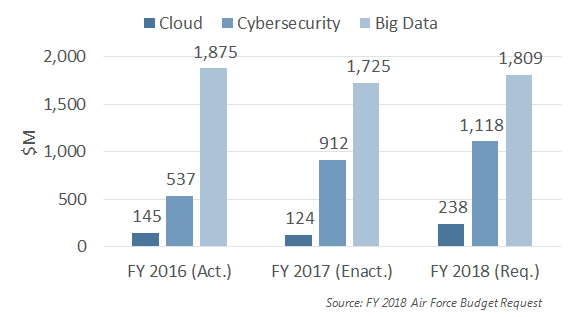Planned FY 2018 Air Force Technology Investments – Cloud, Big Data, Cybersecurity
Published: August 31, 2017
USAFBig DataBudgetCloud ComputingCybersecurityInformation Technology
The Air Force’s FY 2018 Procurement and Research-related budget request shows growth in cloud computing, big data, and cybersecurity.
The Air Force’s Information Dominance strategy and vision is driving initiatives ranging from data center consolidation to unified capabilities, all within the defense-wide construct of the Joint Information Environment. This has led the Air Force to look to transform their enterprise IT, further integrate their Air, Space and Cyberspace systems, and bring IT to bear on their joint warfighting capabilities through technology approaches like cloud computing, big data, and enhanced cybersecurity.
Given the Air Force’s evolution in these technology areas, it can be valuable to explore the Procurement and Research, Development, Test and Evaluation (RDT&E) dollars that the Air Force intends to invest in projects with cloud computing, big data, and/or cybersecurity dimensions – what we could call “related” spending – in fiscal Year 2018.
An analysis of the Air Force’s FY 2018 Procurement and RDT&E budget documentation for key words and terms related to the specific technologies yielded the numbers below. Unfortunately, the data provided in the budget has its limitations and its granularity does not always provide spending specific to cloud, big data, and cybersecurity, so the numbers provided here should be considered approximations that get us in the general range of what the Air Force is spending in each area. In addition, the fact that some programs might contain efforts that address all three technologies means that the requested funding for those programs has been included in total under each technology area. Finally, these are budget figures that include spending on internal personnel expenses, not what the Air Force expects to spend on contracted goods and services related to these areas.
The chart below provides an overview of the combined Procurement and RDT&E spending and requested budgets for FY 2016 – FY 2018 by each technology area.

Spending in all each area has fluctuated somewhat since FY 2016, an indication of the budget, technical, and organizational realities that impact IT at the Air Force and across the Department of Defense. That said, the Air Force wishes to spend more in FY 2018 that in FY 2017 on each area. Growth in projects related to cloud and cybersecurity reflects the significant investment the Air Force is making to modernize and secure its technological capabilities and leverage IT in new ways. And even with relatively flat projections for big data going into FY 2018 the fact that the Air Force has been investing heavily in these capabilities indicates the priority they place on the value BD can bring to information dominance and mission support, and overall effectiveness.
Cloud computing-related projects make up the smallest of the three areas, even though these will see funding growth of greater than +90% compared to the estimated funding received in FY 2017. In all, cloud-related projects will see growth of +64% from funding received in FY 2016.
The Air Force’s funding request in FY 2018 for its cybersecurity-related projects comes in at +23% higher than the total enacted in FY 2017, and +108% higher than what the they reported spending in FY 2016.
Big data-related efforts at the Air Force fare less well than the others, with requested budgets rising +5% from FY 2017 to FY 2018 but coming in -4% below the reported actual budget in FY 2016.
To summarize, Air Force cloud-related programs will see the highest percentage growth in FY 2018, followed by those with a cybersecurity component, and then those with a big data component, although the total funding dedicated to the latter dwarfs outpaces the funding for the other two combined. Many of the Air Force’s cyber programs also leverage cloud and big data technology, however, so rising spending related to big data will also be relevant to cyber capabilities and cloud-enabled systems.